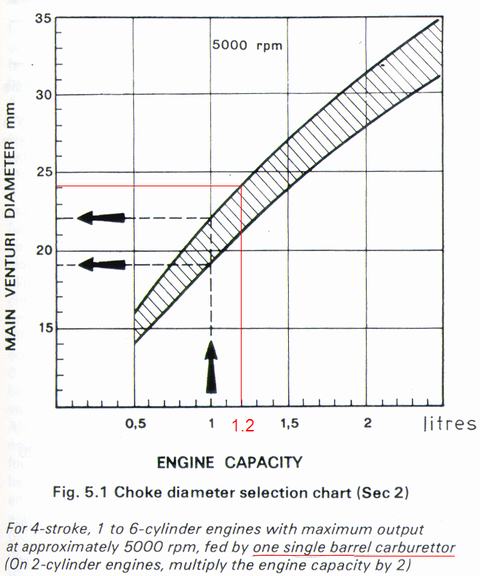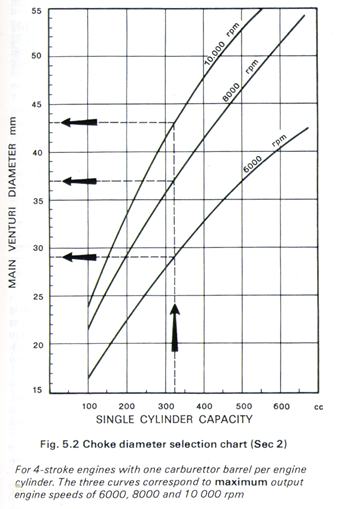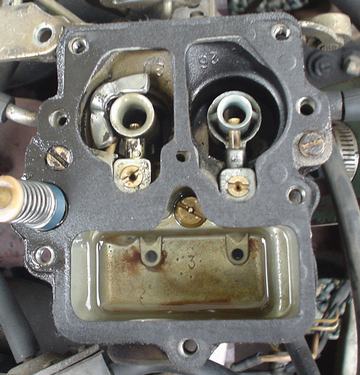Proper carburetor sizing is important for good performance. For maximum power, consult the carburetor manufacturer's recommendations. For good power and great street flexibility, choose a slightly smaller size. Flexibility means smooth action at all RPM ranges and throttle openings (off-idle, part throttle and full throttle).
Contents |
General Sizing Guidelines
For a stock A12 engine (max power at 6000 RPM), choose:
- Single-bore carburetor: 26mm venturi
- Dual 2-choke carbs: 28mm venturis
- Progessive carb: 22 & 26 mm venturis
The carburetor size -- and more specifically, the venturi (choke) size -- is dependent on the type of inlet manifold being used.
Plenum Manifold
From the weber book, for a 1200cc engine at 6000 rpm it looks like a 26mm secondary venturi is called for, based on this chart and interpolating for 6000 rpm based on the DCOE chart. Looking at Nissan's A12 specs, it seems Nissan used the same logic: A12 secondary venturi: 26 mm
Some guidelines suggested by the weber book and this chart:
- For a modified A12 engine with higher RPM range than stock, say for 6,000-8,000 rpm max power, you'd want a bigger carb
- It doesn't matter if it's a 2-cylinder, 4-cylinder or 6-cylinder engine, Weber recommends to use the same size carburetor.
NOTE: This chart is for "single carburetor" feeding all the cylinders (i.e. using a plenum), whether that carb is one or two barrels. For one-barrel per cylinder (example: dual DCOEs on a four cylinder with invididual inlet runners) see the other chart.
Remember that this is just a starting point. Actual test driving or dyno runs will show if slightly bigger or smaller is desired. Like, it depends on what you want, more peak HP at the expense of partial throttle response and low-speed operation, or the reverse. Note the the chart indicates a range of size (the shaded area), but you could go outside that if you wanted to enhance flat-out acceleration and don't care about off-idle performance (example: fitting a DGV Weber 32/36 to a stock A12).
Invidual Runners
For a single carburetor barrel (bore) per cylinder, rather than multiple carbs or bore feeding all cylinder via a plenum, use this chart:
So for our stocker A12 engine (max power at 6000 RPM), choose 28mm venturis.
Progressive Carburetor
All Hitachi DCG306/DCH306 have barrel sizes of:
- 26/30
So they have much smaller barrels than the Weber 32/36.
According to the Nissan factory books:
- The A12 (and A12A) got venturis of 20/26.
- Most A14s are 23/27, but some were 22/27.
- A15s mostly use the 22/27, but Canadian A15s had 23/27.
You can look at the size of you carb, the numbers appear as is this photo. You can shine a flashlight down the air cleaner to see them:
This quotes helps to explain why Nissan gives small primary venturis to our A-series.
- A12 secondary venturi: 20 mm
the difference between the pimary and secondary choke diameters may need to be increased 1 mm or 2 mm in order to give more flexibility at the lower engine speeds.
the secondary choke [venturi] size can be determined from Fig. 5.1 and the primary choke size is normally 1 mm less.
20mm is a lot smaller than the book recommends, but then this road-going car has very good "flexibility at the lower engine speeds".
Note that most A14 carbs are have venturis of 23/27, so that would probably give a good performance boost for a stock A12, without sacrificing driveability.
From the text, it seems this chart applies to a "single carburetor" feeding all the cylinders (i.e. using a plenum), whether that carb is one or two barrels. So why a smaller primary? Well, the usual goal of a progressive carburetors is to give better low speed flexibility. The primary and secondarys will be matched on synchronized carbs like the Weber DGAS 38/38. I don't see why you couldn't do the same with a progressive carb. But if your goal is max performance, the synchronized carb (or carbs) is the usual choice.

![[Datsun 1200 encyclopedia]](/wiki/upload/wiki.png)


